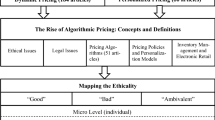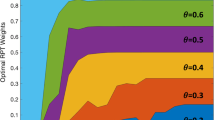Abstract
This paper studies markets for heterogeneous goods using mechanism-design theory. For each combination of desirable properties, we derive an assignment process with these properties in the form of a corresponding direct-revelation game, or we show that it does not exist. Each participant’s utility is quasi-linear in money, and depends upon the allocation that he gets and his privately known multidimensional ‘type.’ The key properties are incentive compatibility, individual rationality, efficiency, and budget balance. The main results characterize mechanisms that are ex post incentive compatible in combination with other properties.
Similar content being viewed by others
Notes
In the case of private values, ex post incentive compatibility is equivalent to dominant strategy incentive compatibility for direct mechanisms. Dominant strategy incentive compatibility states that each agent prefers truth-telling regardless of what other agents report. This is an additional desirable property of mechanisms since it allows agents to optimize without forming any beliefs about the behavior of others.
When we write individual rationality, budget feasibility, and budget balance without any qualifier, we mean “ex post.”
Recall that Cramton et al. (1987) considers Bayesian implementation only.
No distributional assumptions on the type space are needed for the analysis since all mechanism properties are ex post. In other words, there can be arbitrary correlation of types.
Finiteness of \(\mathcal {A}^f\), continuity of \(u_i\), and connectedness of \(\Theta _i\) are assumed to get a revenue equivalence result for the current setting (Lemma 1). Some of these assumptions can be relaxed, perhaps by strengthening others, via the characterization of revenue equivalence in Heydenreich et al. (2009). However, checking the antisymmetry of the distance function for the associated allocation graph of our setup is complicated, see Theorem 1 of Heydenreich et al. (2009). Alternatively, instead of finiteness of \(\mathcal {A}^f\), we can consider probability distributions over finite sets, but, in return we have to use a stronger connectedness assumption (Chung and Olszewski 2007).
The choice of modeling is inspired by Sönmez (1999). He studies a general market without monetary transfers and analyzes when (Pareto) efficient, individually rational, and dominant strategy incentive compatible allocation functions exist. In comparison, we study all implementable allocation functions in markets with transferable utilities for which transfers (via budget balance) plays a critical role.
See Carbajal and Ely (2013) for an analysis of environments when revenue equivalence fails.
With some abuse of notation, \(\theta _{-i_1,\ldots ,i_j}\) is the vector of types for agents other than \(i_1,\ldots ,i_j\). For \(j=0\), \(\theta _{-i_1,\ldots ,i_j}=\theta \).
More precisely, ex post incentive compatibility implies interim incentive compatibility and ex post individual rationality implies interim individual rationality.
Yenmez (2012) studies efficient dissolution of a multi-partnership for agents with private values. He shows that efficient dissolution of multi-partnerships is possible for a convex set that he characterizes.
In general the mechanism satisfying (4) has to be a Groves mechanism but not the VCG mechanism.
Shapley and Scarf (1974) introduce the housing market without the possibility of making transfers. Miyagawa (2001) characterizes allocation functions that are dominant strategy incentive compatible, individually rational, budget balanced, and “collusion-proof” when transfers are allowed. We do not study collusion-proofness but characterize environments for which the efficient allocation function can be implemented with other properties.
Gale and Shapley (1962) introduce the roommates problem without the possibility of making transfers.
Two sets \(A\) and \(B\) are separated in \(X\) if each is disjoint from the other’s closure.
References
Ashlagi I, Braverman M, Hassidim A, Monderer D (2010) Monotonicity and implementability. Econometrica 78:1749–1772
Ausubel LM (2004) An efficient ascending-bid auction for multiple objects. Am Econ Rev 94:1452–1475
Ausubel LM, Milgrom PR (2002) Ascending auctions with package bidding. Front Theor Econ 1:1–42
Bergemann D, Morris S (2005) Robust mechanism design. Econometrica 73:1771–1813
Bergemann D, Morris S (2008) Ex post implementation. Games Econ Behav 63:527–566
Bikhchandani S (2006) Ex post implementation in environments with private goods. Theor Econ 1:369–393
Bikhchandani S, Chatterji S, Lavi R, Mu’alem A, Nisan N, Sen A (2006) Weak monotonicity characterizes deterministic dominant-strategy implementation. Econometrica 74:1109–1132
Carbajal JC, Ely JC (2013) Mechanism design without revenue equivalence. J Econ Theory 148:104–133
Carbajal JC, McLennan A, Tourky R (2013) Truthful implementation and preference aggregation in restricted domains. J Econ Theory 148:1074–1101
Chung K.-S., Ely J.C. (2002) Ex-post incentive compatible mechanism design. Manuscript.
Chung K-S, Olszewski W (2007) A non-differentiable approach to revenue equivalence. Theor Econ 2:469–487
Clarke EH (1971) Multipart pricing of public goods. Public Choice 11:17–33
Cramton P, Gibbons R, Klemperer P (1987) Dissolving a partnership efficiently. Econometrica 55:615–632
Crémer J, McLean RP (1985) Optimal selling strategies under uncertainty for a discriminating monopolist when demands are interdependent. Econometrica 53:345–361
d’Aspremont C, Gérard-Varet L-A (1979) Incentives and incomplete information. J Public Econ 11:25–45
Fieseler K, Kittsteiner T, Moldovanu B (2003) Partnerships, lemons and efficient trade. J Econ Theory 113:223–234
Galavotti S, Muto N, Oyama D (2011) On efficient partnership dissolution under ex post individual rationality. Econ Theor 48:87–123
Gale D, Shapley LS (1962) College admissions and the stability of marriage. Am Math Mon 69:9–15
Green JR, Laffont J-J (1979) Incentives in public decision-making. Amsterdam, North-Holland
Groves T (1973) Incentives in teams. Econometrica 41:617–631
Gul F, Stacchetti E (2000) The english auction with differentiated commodities. J Econ Theory 92:66–95
Heydenreich B, Müller R, Uetz M, Vohra RV (2009) Characterization of revenue equivalence. Econometrica 77:307–316
Holmstrom B (1977) On incentives and control in organization. Ph.D. thesis, Stanford University.
Holmstrom B, Myerson RB (1983) Efficient and durable decision rules with incomplete information. Econometrica 51:1799–1819
Hurwicz L, Walker M (1990) On the generic nonoptimality of dominant-strategy allocation mechanisms: a general theorem that includes pure exchange economies. Econometrica 58:683–704
Jehiel P, Meyer-ter-Vehn M, Moldovanu B, Zame WR (2006) The limits of ex post implementation. Econometrica 74:585–610
Jehiel P, Pauzner A (2006) Partnership dissolution with interdependent values. Rand J Econ 37:1–22
Kosenok G, Severinov S (2008) Individually rational, budget-balance mechanisms and allocation of surplus. J Econ Theory 140:126–161
Krishna V, Maenner E (2001) Convex potentials with an application to mechanism design. Econometrica 69:1113–1119
Krishna V, Perry M (1998) Efficient mechanism design. Discussion paper
Laffont J-J, Maskin E (1980) A differential approach to dominant strategy mechanisms. Econometrica 48:1507–1520
Makowski L, Mezzetti C (1994) Bayesian and weakly robust first best mechanisms: characterizations. J Econ Theory 64:500–519
Maskin E (1992) Auctions and privatization. In: Privatization. Institut fur Weltwirtschaften der Universität Kiel, Kiel
Milgrom P, Segal I (2002) Envelope theorems for arbitrary choice sets. Econometrica 70:583–601
Miyagawa E (2001) House allocation with transfers. J Econ Theory 100:329–355
Moldovanu B (2002) How to dissolve a partnership. J Inst Theor Econ JITE 158:66–80
Myerson RB, Satterthwaite MA (1983) Efficient mechanisms for bilateral trading. J Econ Theory 29:265–281
Roberts K (1979) The characterization of implementable choice rules. In: Aggregation and revelation of preferences. Elsevier, North-Holland
Rochet J-C (1987) A necessary and sufficient condition for rationalizability in a quasi-linear context. J Math Econ 16:191–200
Shapley LS, Scarf HE (1974) On cores and indivisibility. J Math Econ 1:23–37
Sönmez T (1999) Strategy-proofness and essentially single-valued cores. Econometrica 67:677–689
Vickrey W (1961) Counterspeculation, auctions, and competitive sealed tenders. J Financ 16:8–37
Walker M (1980) On the nonexistence of a dominant strategy mechanism for making optimal public decisions. Econometrica 48:1521–1540
Williams SR (1999) A characterization of efficient, Bayesian incentive compatible mechanisms. Econ Theor 14:155–180
Wilson R (1987) Game-theoretic analyses of trading processes. In: Advances in economic theory: Fifth World Congress. Cambridge University Press, pp 33–70
Yenmez MB (2012) Dissolving multi-partnerships efficiently. J Math Econ 48:77–82
Yenmez MB (2013) Incentive-compatible matching mechanisms: consistency with various stability notions. Am Econ J Microecon 5:120–141
Acknowledgments
This paper is a part of my dissertation submitted to Stanford University, and it has been circulated as a part of “Incentive Compatible Market Design with an Application to Matching with Wages”. I would like to thank the co-editor, Vijay Krishna, and two anonymous referees. I am grateful to my advisors Michael Ostrovsky, Andrzej Skrzypacz, and Robert Wilson for continuous guidance and support. I thank Jeremy Bulow, Itay Fainmesser, Yossi Feinberg, Alexander Frankel, John Hatfield, Onur Kesten, John Lazarev, John Ledyard, Hongyi Li, Naz Nami, Muriel Niederle, Michael Schwarz, Daniel Taylor, Ali Yurukoglu, and seminar participants at various institutions for helpful comments. The author acknowledges the financial support of the SIEPR Leonard W. Ely & Shirley R. Ely Graduate Student Fellowship. Part of this research was conducted at Microsoft Research New England.
Author information
Authors and Affiliations
Corresponding author
Rights and permissions
About this article
Cite this article
Yenmez, M.B. Incentive compatible market design with applications. Int J Game Theory 44, 543–569 (2015). https://doi.org/10.1007/s00182-014-0444-8
Accepted:
Published:
Issue Date:
DOI: https://doi.org/10.1007/s00182-014-0444-8




